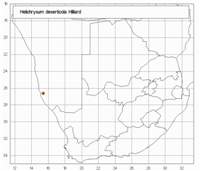Origin of name:
deserticola = dweller in deserts
Diagnostic characters:
Compact herbSmall woolly leavesSmall headsBracts straw-coloured
Description:
Probably perennial, taproot becoming thick (4 mm diam.) and woody, stems many, densely tufted from the crown, c. 20-60 mm long, simple or subsimple, grey-woolly, leafy. Leaves mostly 4-10 x 1-4 mm, elliptic-spathulate, apex subacute, sometimes folded lengthwise and recurved, base narrowed, half-clasping, margins somewhat undulate, both surfaces thickly white-woolly. Heads heterogamous or rarely homogamous, c. 3.5-4 x 2-2.5 mm, campanulate, few to many crowded in terminal glomerules 5-10 mm across, surrounded by leaves webbed to the outer involucral bracts. Involucral bracts in 3-4 series, subequal, equaling flowers, not radiating, tips of outer obtuse, inner abruptly acute and apiculate, opaque, white, outer at least tinged golden-brown. Receptacle very shortly honeycombed. Flowers 14-38, (0-) 1-3 female, 14-36 homogamous, yellow, tipped pink. Achenes 0.75 mm, glabrous. Pappus bristles many, equaling corolla, tips scabrid, bases nude, not cohering.
Flowering between July and October.
Distribution:
Grows on sandy or rocky flats. Recorded only from southernmost Namibia (Kaukausib, Rote Kuppe, Garub).
Desert Biome.
Notes:
Rarely collected.
Closely allied to H. obtusum but distinguished by the opaque white tips to the involucral bracts, the innermost of which are abruptly contracted into a sharp apiculus.
Taxonomy:
Literature:
Helichrysum deserticola Hilliard in Flora of southern Africa 33,7 (2): 168 (1983).
Type:
Namibia, Gubub [Garub?], sandflats, 18 x 1922, Dinter 4115 (SAM, holo.; BM; G; Z, iso.).
Synonym(s):
Vouchers:
Dinter 3814 (BOL; PRE); Range 1130 (SAM).
